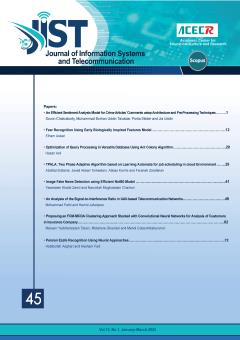As Cognitive Radio (CR) used in video applications, user-comprehended video quality practiced by secondary users is an important metric to judge effectiveness of CR technologies. We propose a new adaptive modulation and coding (AMC) scheme for CR, which is OFDM based sy
More
As Cognitive Radio (CR) used in video applications, user-comprehended video quality practiced by secondary users is an important metric to judge effectiveness of CR technologies. We propose a new adaptive modulation and coding (AMC) scheme for CR, which is OFDM based system that is compliant with the IEEE.802.16. The proposed CR alters its modulation and coding rate to provide high quality system. In this scheme, CR using its ability to consciousness of various parameters including knowledge of the white holes in the channel spectrum via channel sensing, SNR, carrier to interference and noise ratio (CINR), and Modulation order Product code Rate (MPR) selects an optimum modulation and coding rate. In this scheme, we model the AMC function using Artificial Neural Network (ANN). Since AMC is naturally a non-liner function, ANN is selected to model this function. In order to achieve more accurate model, Genetic algorithm (GA) and Particle Swarm Optimization (PSO) are selected to optimize the function representing relationship between inputs and outputs of ANN, i.e., AMC model. Inputs of ANN are CR knowledge parameters, and the outputs are modulation type and coding rate. Presenting a perfect AMC model is advantage of this scheme because of considering all impressive parameters including CINR, available bandwidth, SNR and MPR to select optimum modulation and coding rate. Also, we show that in this application, GA rather than PSO is better choice for optimization algorithm.
Manuscript profile


